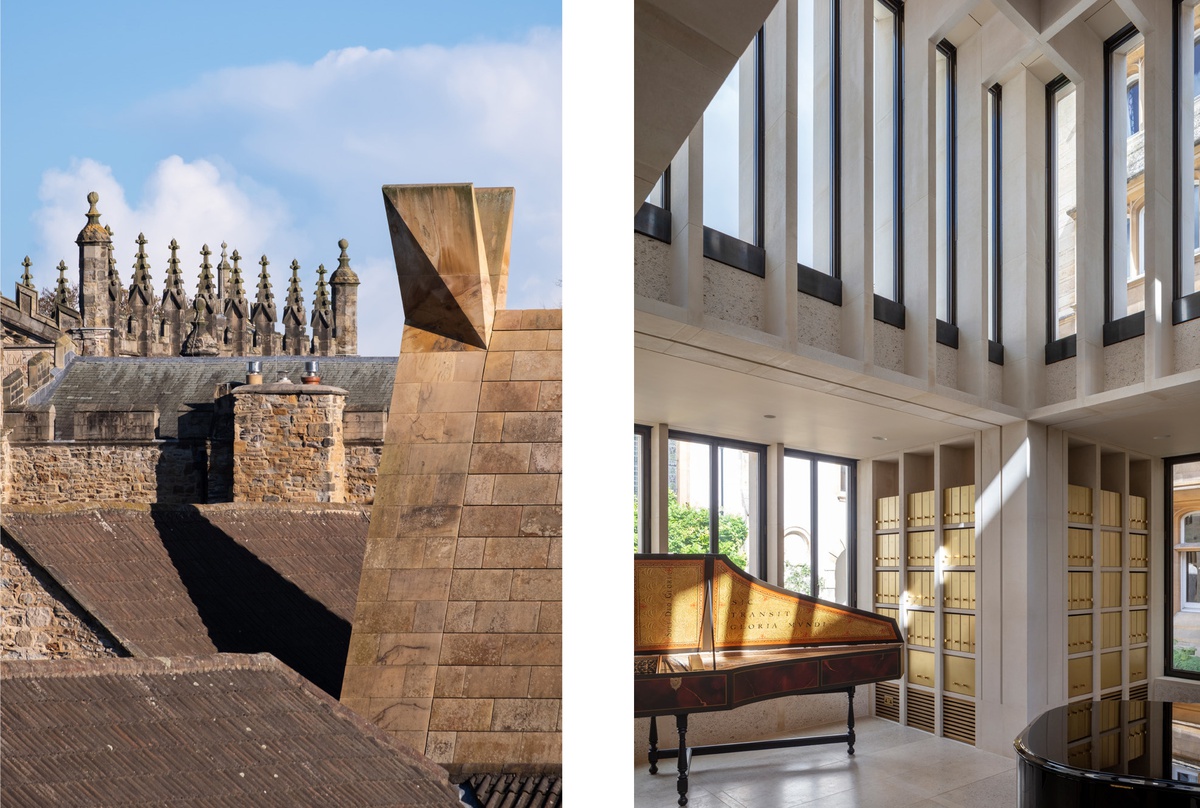TWO RIBA NATIONAL AWARD WINS
JULY 2024

The WongAvery Music Gallery for Trinity Hall in Cambridge and Auckland Castle, Tower & Faith Museum have both won RIBA National Awards.
The Auckland Project was founded by philanthropist Jonathan Ruffer. The project is one of a series of urban and historic interventions that seek to preserve the Castle’s heritage, promote Bishop Auckland as a visitor destination and reinvigorate the town. The Castle project by Purcell Architects involved the conservation of the state apartments and domestic rooms, and the provision of new learning, catering, retail and visitor facilities. It sought to increase visitor engagement and bring to life the forgotten story of the Prince Bishops and their role in the nation’s past. In its pivotal location, the form and construction of the Auckland Tower is intended to echo lightweight provisional structures that would once have clustered around Castle walls. It allows people a view into the Castle to understand this previously secluded world. The new Faith Museum extension to the Castle takes the simple form of a barn with certain details developed to project a public representation of a sacred function and provides space for exhibition displays on faith in Britain. The Auckland project has previously been awarded an RIBA North East Building of the Year and North East Conservation Award.
The WongAvery Gallery is a music practice and performance space for Trinity Hall, Cambridge. The new building sits in the centre of Avery Court. The aim of this project was not only to provide a much-needed dedicated space for music practice and performance, but also to rejuvenate Avery Court by relandscaping the court around the new building in a collaboration with Kim Wilkie. It also houses environmentally sensitive musical instruments and the college’s music library. the Jury commented on the project “The jury left the pavilion having absorbed a sense of calm unusual in any building. This is an admirable project in the way it has set out exceptional architectural ambitions and succeeded in seeing them through both design and construction with outstanding rigour and attention to detail.”
FROM WORKSHOP TO SITE
SEPTEMBER 2020

At Millimetre’s workshop in Brighton, a tremendous steel skeleton has been rapidly emerging. It will form the delicate superstructure of a garden pavilion-cum-guesthouse destined for the Isle of Wight. In the main hangar, a healthy collection of gently oxidizing off-the-shelf steel sections and staggeringly sharp, bespoke milled elements is set back from a row of socially-distanced workspaces. Millimetre’s metal workers have been working around the clock (and in the excessive summer heat) to cut, weld and grind the heap in front of them into the many precise modular components that will form the pavilion’s columns, floor and roof. An assembly line has been formed to increase the efficiency of fabrication, with a station each for repetitive rotary welding tasks, rotary grinding, welding using custom jigs and more complicated non-linear welds. As the steel passes through the workshop, glistening segments come to form elaborate sculptures. Adjacent to the metalworking bays is a six-axis robot arm programmed to cut high density foam into jigs for the most intricate welding alignments. This will be essential to the success of the central roof truss node, where nine tubular sections converge. More on this will follow at a later date.

The pavilion will be lifted off the ground by cantilevering trusses held from the main columns, which are formed of four tubular sections tied together by intermittent thin plates along their height. The lower portions of these columns, which sit beneath the floor build-up, are amicably referred to as the daleks. These stub columns are the first pieces to be finalized, quickly assembled in tandem to confirm tolerances, and sent away to be painted for corrosion protection before arriving to site.

On the northeast coast of the Isle of Wight, the site falls to overlook a protected marshland with tidal flows fed by the Solent. A shallow depression with raking banks at the bottom of the hill will conceal the feet of the pavilion superstructure; the baseplates of the stub columns now erected atop the long strip foundations and adjoined to form the triangulated support for the floor and deck above. Located to capture rainwater dropping from the overhanging roof eaves, the perimeter gravel drain will also mark the boundary between building and landscape, with tall, wild grasses merging with the wetland beyond..

As the pavilion envelope will be formed largely of full-width glass spans closely abutting the columns, erecting the steel frame precisely is critical. Despite a remarkable installation tolerance of +/- 3mm diagonally across each 5 x 5m bay, the stub columns must be shimmed to ensure exact alignment and verticality. Between them, the galvanised (and thus silvery) internal floor beams are distinguishable from the external floor beams, which are coated to resist corrosion and painted to achieve a warm metallic finish. With the cantilevering terrace beams installed additionally, a datum is formed approximately 180mm below the intended finished floor level from which the remainder of the pavilion will rise..

Back in Brighton, the columns which will stand on the shoulders of the stubs now installed on site are laid out one by one. Their height and slenderness astound – a true feat for the structural engineers, Smith & Wallwork. It is through, not around these columns that the thermal envelope will run, with tall and narrow glazing centred on each column between the four vertical tubes. The next test-build will involve hoisting up these columns, narrowly missing the suspended lights of the workshop, to bolt on the roof trusses via the halving joints rigidly reaching out to receive them. That dramatic and exciting update will have to follow.







